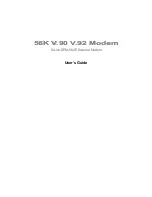
1. Radio Modem MR400 (MR300, MR160
)
MR 400, MR300 and MR160 are conceptually new radio modems designed for transmitting data in the VHF and UHF
bands. The radio modem uses 4-state FSK modulation providing for a maximum signalling rate of 21.68 kbit/s. The
radio modem is of modular design with one to four standard RS232 ports (an RS422 or RS485 port can be used in
place of two of them) available to the user. The configuration can be extended by an Ethernet interface and also by a
module with analog and digital inputs/outputs, which is normally provides two analog inputs and outputs and two
digital inputs and outputs. The radio data transceiver module can be configured to an arbitrary frequency of the
transmitter and receiver within the 3.2 MHz frequency range in a 12.5 kHz channel raster. The receiving and
transmitting frequencies are mutually independent and are derived from the frequencies of four Phase-Locked Loops
programmed by the transceiver microprocessor. Channel settings are stored in the transceiver EEPROM memory and
the FLASH memory module of the modem whose central processor controls the operation of the transceiver
microprocessor. The RF output power of the radiomodem transmitter’s high frequency signal is software-configurable
in sixteen steps from 0.1 to 5 W. The software configuration of MR400 is backward compatible with that of the MR25
radio modem. A description of software control and configuration of the MR25 is available in publications describing
MORSE Firmware.
Important
ATTENTION! The radio modem is equipment which can only be operated in the Czech Republic on the basis
of Permission to operate transmitting radio stations issued by the Department of Frequency Spectrum
Management at the Czech Telecommunication Office.
4



































